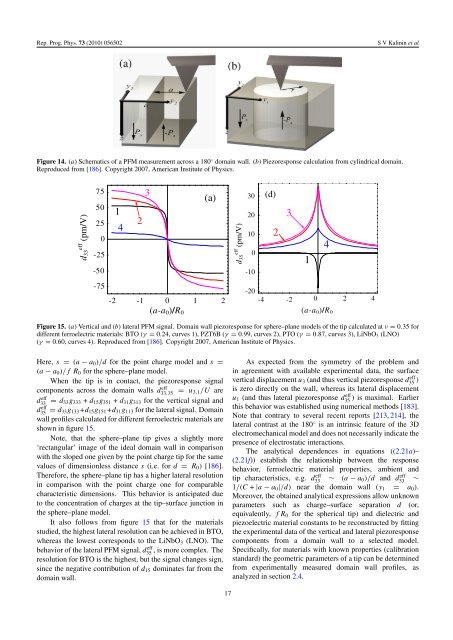Local polarization dynamics in ferroelectric materials
Local polarization dynamics in ferroelectric materials
Local polarization dynamics in ferroelectric materials
You also want an ePaper? Increase the reach of your titles
YUMPU automatically turns print PDFs into web optimized ePapers that Google loves.
Rep. Prog. Phys. 73 (2010) 056502<br />
S V Kal<strong>in</strong><strong>in</strong> et al<br />
Figure 14. (a) Schematics of a PFM measurement across a 180 ◦ doma<strong>in</strong> wall. (b) Piezoresponse calculation from cyl<strong>in</strong>drical doma<strong>in</strong>.<br />
Reproduced from [186]. Copyright 2007, American Institute of Physics.<br />
(pm/V)<br />
d 33<br />
eff<br />
75 3<br />
50<br />
25<br />
1<br />
2<br />
4<br />
(a)<br />
0<br />
-25<br />
-50<br />
-75<br />
-2 -1 0 1 2<br />
(a-a 0 )/R 0<br />
(pm/V)<br />
d 35<br />
eff<br />
30<br />
20<br />
10<br />
0<br />
(d)<br />
3<br />
2<br />
4<br />
1<br />
-10<br />
-20<br />
-4 -2 0 2 4<br />
(a-a 0 )/R 0<br />
Figure 15. (a) Vertical and (b) lateral PFM signal. Doma<strong>in</strong> wall piezoresponse for sphere–plane models of the tip calculated at ν = 0.35 for<br />
different <strong>ferroelectric</strong> <strong>materials</strong>: BTO (γ = 0.24, curves 1), PZT6B (γ = 0.99, curves 2), PTO (γ = 0.87, curves 3), LiNbO 3 (LNO)<br />
(γ = 0.60, curves 4). Reproduced from [186]. Copyright 2007, American Institute of Physics.<br />
Here, s = (a − a 0 )/d for the po<strong>in</strong>t charge model and s =<br />
(a − a 0 )/f R 0 for the sphere–plane model.<br />
When the tip is <strong>in</strong> contact, the piezoresponse signal<br />
components across the doma<strong>in</strong> walls d33,35 eff = u 3,1/U are<br />
d33 eff = d 33g 333 + d 15 g 351 + d 31 g 313 for the vertical signal and<br />
d35 eff = d 33g 133 +d 15 g 151 +d 31 g 113 for the lateral signal. Doma<strong>in</strong><br />
wall profiles calculated for different <strong>ferroelectric</strong> <strong>materials</strong> are<br />
shown <strong>in</strong> figure 15.<br />
Note, that the sphere–plane tip gives a slightly more<br />
‘rectangular’ image of the ideal doma<strong>in</strong> wall <strong>in</strong> comparison<br />
with the sloped one given by the po<strong>in</strong>t charge tip for the same<br />
values of dimensionless distance s (i.e. for d = R 0 ) [186].<br />
Therefore, the sphere–plane tip has a higher lateral resolution<br />
<strong>in</strong> comparison with the po<strong>in</strong>t charge one for comparable<br />
characteristic dimensions. This behavior is anticipated due<br />
to the concentration of charges at the tip–surface junction <strong>in</strong><br />
the sphere–plane model.<br />
It also follows from figure 15 that for the <strong>materials</strong><br />
studied, the highest lateral resolution can be achieved <strong>in</strong> BTO,<br />
whereas the lowest corresponds to the LiNbO 3 (LNO). The<br />
behavior of the lateral PFM signal, d35 eff , is more complex. The<br />
resolution for BTO is the highest, but the signal changes sign,<br />
s<strong>in</strong>ce the negative contribution of d 15 dom<strong>in</strong>ates far from the<br />
doma<strong>in</strong> wall.<br />
As expected from the symmetry of the problem and<br />
<strong>in</strong> agreement with available experimental data, the surface<br />
vertical displacement u 3 (and thus vertical piezoresponse d35 eff)<br />
is zero directly on the wall, whereas its lateral displacement<br />
u 1 (and thus lateral piezoresponse d35 eff ) is maximal. Earlier<br />
this behavior was established us<strong>in</strong>g numerical methods [183].<br />
Note that contrary to several recent reports [213, 214], the<br />
lateral contrast at the 180 ◦ is an <strong>in</strong>tr<strong>in</strong>sic feature of the 3D<br />
electromechanical model and does not necessarily <strong>in</strong>dicate the<br />
presence of electrostatic <strong>in</strong>teractions.<br />
The analytical dependences <strong>in</strong> equations ((2.21a)–<br />
(2.21f)) establish the relationship between the response<br />
behavior, <strong>ferroelectric</strong> material properties, ambient and<br />
tip characteristics, e.g. d33 eff ∼ (a − a 0 )/d and d eff<br />
33<br />
∼<br />
1/(C + |a − a 0 |/d) near the doma<strong>in</strong> wall (y 1 = a 0 ).<br />
Moreover, the obta<strong>in</strong>ed analytical expressions allow unknown<br />
parameters such as charge–surface separation d (or,<br />
equivalently, fR 0 for the spherical tip) and dielectric and<br />
piezoelectric material constants to be reconstructed by fitt<strong>in</strong>g<br />
the experimental data of the vertical and lateral piezoresponse<br />
components from a doma<strong>in</strong> wall to a selected model.<br />
Specifically, for <strong>materials</strong> with known properties (calibration<br />
standard) the geometric parameters of a tip can be determ<strong>in</strong>ed<br />
from experimentally measured doma<strong>in</strong> wall profiles,<br />
analyzed <strong>in</strong> section 2.4.<br />
as<br />
17
















